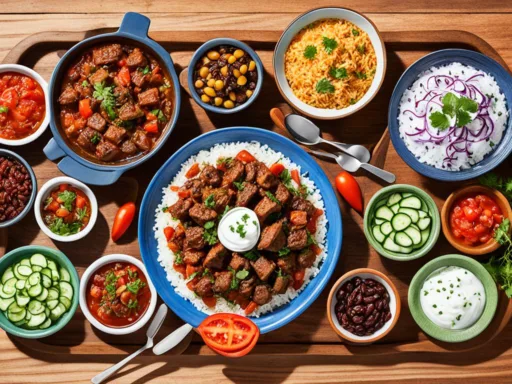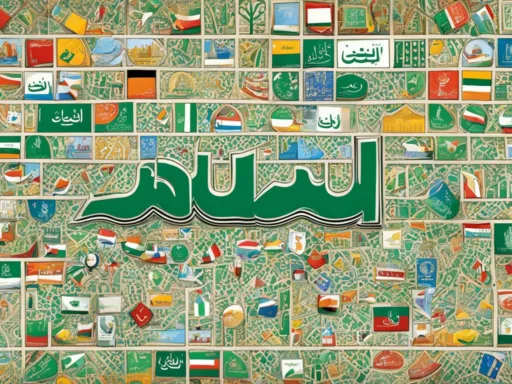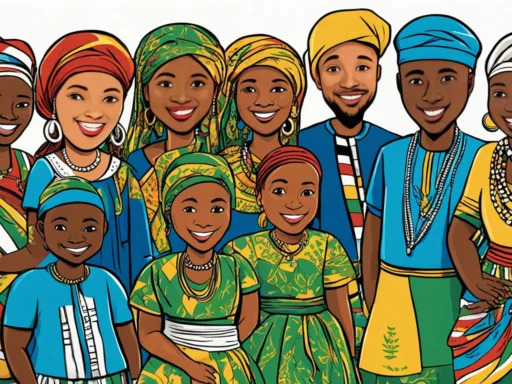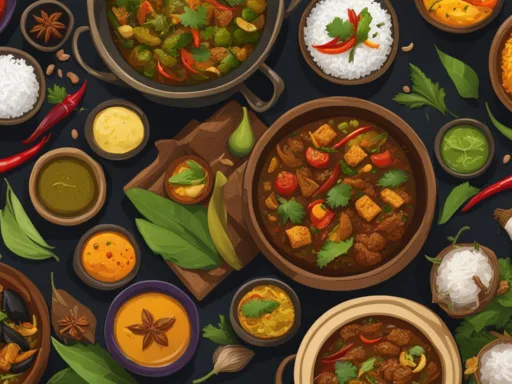The Republic of Djibouti stands as a remarkable testament to linguistic diversity, where multiple languages spoken in Djibouti coalesce to form a rich cultural fabric. Situated in the Horn of Africa, this small nation boasts a multilingual Djibouti society, where daily interactions are navigated through a variety of Djiboutian dialects. Alongside the widespread native tongues, official languages in Djibouti—Arabic and French—play a strategic role in government, education, and international relations. The harmonious coexistence of varied languages underlines the country’s openness to both tradition and modern influences.
Key Takeaways
- Djibouti’s official languages are Arabic and French, reflecting the nation’s historic ties and global connections.
- Local dialects of Somali and Afar are integral to Djibouti’s linguistic identity, with deep roots in the ethnic heritage of the people.
- Multilingualism in Djibouti is a societal norm, contributing to the country’s vibrant cultural tapestry.
- Arabic, beyond its official status, holds special significance due to its religious and cultural resonance within the community.
- The prevalence of French as a medium of education emphasizes Djibouti’s continued engagement with francophone spheres.
- The presence of immigrant languages adds to the dynamic linguistic environment of Djibouti, showcasing the nation’s diversity.
Multilingualism in Djibouti: Beyond the Official Languages
In Djibouti, the rich tapestry of language offers a glimpse into the nation’s heart, where the oral traditions of the Afar language and the Somali language are passed from one generation to the next. It is a society where communication is an art form, painted with the diverse palette of national languages Djibouti and the subtle undertones of Djibouti language diversity. Here, language is more than a tool for conversation; it’s the pulse of culture, the rhythm of daily life, and a testament to the country’s commitment to linguistic inclusivity.
National Languages: Somali and Afar
The Somali language, with its Northern dialect predominant in Djibouti, serves as a linguistic bridge, connecting the people across not only Djibouti’s terrains but also beyond its borders. Similarly, the Afar language provides a unique cultural identity with deep ethnic roots in the region. Not content with mere spoken words, these national languages have embraced the Latin script to preserve their heritage and ensure their stories endure.
Djiboutian Arabic: A Unique Linguistic Identity
The linguistic narrative of Djibouti is further enriched by the distinctive flair of Djiboutian Arabic. Markedly different from its Modern Standard Arabic counterpart, this local dialect—affectionately called Ta’izzi-Adeni Arabic—embodies the unique socio-cultural tapestry that is distinctively Djiboutian. Its colloquial charm is an essential part of everyday life, imbuing the nation with its linguistic individuality.
Indigenous Languages Spoken in Djibouti
The commitment to embracing all cultural facets extends to the realm of indigenous languages Djibouti. Even the silence has its own voice here, artfully expressed through Somali Sign Language, empowering the deaf community with linguistic inclusion. This recognition of diverse means of communication reflects an understanding of language as the soul of Djibouti’s community—a map charting the nation’s history, relationships, and growth.

- **Somali Language**
- Primarily oral tradition
- Northern dialect most common
- Latin script orthography
- **Afar Language**
- Deeply rooted ethnic heritage
- Latin script formalized alphabet
- **Djiboutian Arabic**
- Distinct from Modern Standard Arabic
- Integral to local identity
- **Indigenous Languages**
- Includes Somali Sign Language
- Essential for cultural inclusivity
As the languages of Djibouti dance through the air—each with its own melody and cadence—they create a symphony of expressive richness that can be found nowhere else on Earth. This is the nation’s linguistic heritage: a diverse, vibrant, and inclusive culture resonating with the sounds of its people.
Linguistic Ties to History and Culture: Arabic and French in Djibouti

The official languages in Djibouti, Arabic and French, are not merely tools of communication; they are living chronicles of the nation’s rich past. The Arabic language reverberates with historical depth, serving the dual purpose of fulfilling religious needs and nurturing the cultural identity of Djiboutians. As one of the official languages in Djibouti, Arabic facilitates the religious practices and daily lives of the majority Muslim population.
On the other hand, the French language echoes the era of European influence brought about by Djibouti colonial history. As a legacy of French colonization, French continues as the administrative language and delineates Djibouti’s affiliation to French-speaking nations, solidifying its role in global dialogue. In the realm of education, French serves as the primary medium, ensuring the nation’s youth are well-equipped for both local governance and international stewardship.
Arabic and French languages in Djibouti symbolize a bridge between the generational wisdom of traditions and the aspirations of contemporary progress. They embody the resilience and adaptability of a nation steering through the tides of time.
The bilingual signage visible across Djibouti’s landscape embodies the coexistence of these languages. From the gates of the Djibouti-Ambouli International Airport to the corridors of higher education institutions, Arabic and French are pillars supporting the archway into Djibouti’s future.
| Linguistic Influence | Uses in Djibouti | Cultural Significance |
|---|---|---|
| Arabic Language | Official government business, religious ceremonies, everyday communication | Religious practices, cultural affairs, educational curriculum |
| French Language | Administrative proceedings, primary medium of education, diplomacy | Historical connection to French colonial era, gateway to international relations |
In embracing both the Arabic and French languages, Djibouti does not merely honor its history; it weaves these linguistic strands into its development narrative, constantly renegotiating its identity in a fast-moving world. This linguistic duality offers a lens through which to view the past, a tool to operate in the present, and a guide towards an interconnected future.
Languages Spoken in Djibouti: Embracing Diversity
The Djibouti multilingual society is a striking example of how language and culture intertwine to form the foundation of a nation’s identity. In Djibouti, the convergence of common languages in Djibouti paves the way for a rich and inclusive community. The significance of this diversity is most evident in the spheres of society and education in Djibouti, where multilingual capabilities are seen as valuable assets for personal and professional growth.
The Impact of Multilingualism on Society and Education
In an era where global connectivity is paramount, the ability to communicate in multiple languages provides Djiboutians with a tangible advantage in various sectors, including politics and education. Fluency in French, for instance, grants access to broader educational resources and empowers individuals to partake actively in the nation’s political discourse. As regional languages in Djibouti mesh with academic and political institutions, they create a versatile and dynamic framework for progress.
Multilingualism in Djibouti also enhances social cohesion, ensuring that diverse linguistic groups enjoy representation and that cultural competencies are brought to the fore. The impact on the education system in Djibouti is undeniable, as students navigate a curriculum that is rich in linguistic variety, preparing them to contribute to the nation’s development and to the global community.
Language Map of Djibouti: Understanding Geographic Linguistic Distribution
The language map of Djibouti doesn’t simply chart territories; it tells the story of human connections, trade routes, historical migrations, and societal evolution. This spatial representation reveals intricate patterns of language demographics in Djibouti, providing insights into the distribution of languages such as Somali and Afar across the nation’s landscape.
Exploring the language map is a voyage into the heart of Djibouti’s multiculturalism, showing how regional languages in Djibouti permeate the fabric of daily life. From the bustling streets of the capital to remote pastoral communities, this map serves as a guide, illustrating the interplay between language, location, and identity.

As we delve deeper into the language demographics, we see a society that is resilient in its diversity, educated in multiple tongues, and united in its multifaceted identity. Djibouti stands as a beacon of multilingualism, a testament to the cultural wealth that a diversity of languages can bring to a nation.
- Education in Djibouti:
- French as the primary language of instruction
- Enhanced competitiveness through multilingual curricula
- Language Demographics:
- Insights into society and cultural identities
- Distribution of Somali and Afar languages across regions
- Regional Languages in Djibouti:
- Illustration of diverse linguistic presence
- Societal integration of diverse linguistic communities
In the intricate dance of languages that is the hallmark of Djibouti’s societal stage, multilingualism not only enriches personal and communal life but also serves as a linchpin for unity and understanding. This melange of languages, celebrated in daily life and institutional settings, underlines the profound impact of embracing linguistic diversity on a nation’s fabric.
Official and Vernacular: A Closer Look at Djibouti’s Language Dynamics

In the compact yet culturally rich nation of Djibouti, the interplay between Djibouti official languages and various vernacular tongues paints a vivid picture of the nation’s societal framework. With Arabic and French holding the status of official languages, they underscore Djibouti’s historical connections and serve as pivotal instruments in statecraft and educational systems. These languages act as gateways—both to the country’s Islamic traditions and to its legacies of European engagement.
However, the heartbeat of Djibouti’s language dynamics thrives within its vernacular languages. Somali and Afar, deeply ingrained in the social fabric, give voice to the collective ethos and personal narratives of the nation’s ethnic groups. These local languages, passed down through generations, now adapt with modern scripts yet retain their oral fervor—maintaining the country’s rich oral traditions and fostering communal ties.
Further enriching the linguistic landscape, immigrant languages add to the intricate mosaic of everyday communication. The richness of vernacular languages Djibouti is a testament to a society that embraces its ethnolinguistic diversity while navigating the modern currents of global interaction.
Language diversity in Djibouti reflects the nation’s openness to cultural convergence, respecting the past while innovating for the future.
Displaying this multifaceted linguistic identity, the following language diversity table elucidates the roles and relevance of both official and regional languages in various aspects of Djiboutian life:
| Language | Role in Djibouti | Relevance |
|---|---|---|
| Arabic | Official processes, religious contexts | Symbol of Islamic culture and administrative conduit |
| French | Educational medium, international diplomacy | Historical legacy, link to Francophonie |
| Somali | Social communication, ethnic identity | Linguistic bridge within and beyond borders |
| Afar | Cultural expression, community affairs | Preservation of ethnic heritage |
The tableau above reveals how Djibouti’s official languages and vernacular dialogues interconnect, creating a network of communication channels integral to the nation’s identity. This intricate balance of languages is a beacon of linguistic inclusivity, propelling Djibouti towards a future where tradition and modernity are in continuous conversation.
Conclusion: Djibouti’s Linguistic Landscape – A Unique Cultural Symphony
As we draw the curtains on this exploration of language diversity Djibouti, it’s evident that the nation’s multicultural voice is a powerful symbol of unity and identity. Djibouti stands out as a multilingual nation, seamlessly blending various languages into the everyday lives of its citizens. The official dialects provide a doorway to administrative and educational realms, while regional languages offer a warm embrace of the country’s linguistic heritage. As a cultural crossroads, Djibouti illustrates the beauty of language as a dynamic and living entity, ever-evolving yet firmly rooted in tradition.
This tiny yet impressive nation encapsulates the essence of linguistic cohabitation and shows the world how diversity in language can enrich a society. The harmonious linguistic fabric of Djibouti, composed of Arabic, French, Somali, Afar, and a suite of immigrant tongues, has not only shaped the nation’s history but continues to forge a collective future. This intricate medley of voices ensures that the vibrant stories of Djibouti will linger through generations. The resilience to maintain this legacy and adapt to linguistic advancements underscores the robust adaptability of the Djiboutian spirit.
In the veneration of this versatile array of dialects, Djibouti embodies a profound sense of cultural pride and an openness to the winds of change, making it a distinguished case study in the preservation and nurturing of a rich linguistic tapestry. As the world becomes increasingly connected, Djibouti’s commitment to fostering its multilingual heritage stands as a shining example to other nations. We can collectively learn from Djibouti’s dedication to language inclusivity, as it plays a pivotal role in defining the nation’s identity and propelling it on the global stage—a testament to the enduring power of language in connecting and empowering communities.
FAQ
What are the official languages in Djibouti?
The official languages in Djibouti are Arabic and French. These languages play a vital role in government, education, and international diplomacy.
What national languages are spoken in Djibouti?
The national languages of Djibouti are Somali and Afar. These languages reflect the ethnic majorities within the country and are integral to Djibouti’s cultural identity.
Can you tell me more about Djiboutian Arabic?
Djiboutian Arabic, also known as the Ta’izzi-Adeni Arabic dialect, is a unique form of Arabic spoken by about 59,000 people in Djibouti. It differs from Modern Standard Arabic and is one of the vernacular languages adding to the country’s linguistic diversity.
Are there other indigenous languages spoken in Djibouti?
In addition to Somali and Afar, Djibouti is home to a vibrant community of immigrants who speak various languages. Furthermore, unique adaptations such as the Somali Sign Language are also used, reflecting the country’s inclusive approach to communication.
How does Djibouti’s colonial history influence its languages?
French, a legacy of Djibouti’s colonial history with France, continues to be widely used in education and administrative affairs. It stands alongside Arabic as a language that shapes the country’s historical narrative and present-day global connections.
What impact does multilingualism have on Djiboutian society and education?
Multilingualism is a hallmark of Djiboutian society, fostering cultural inclusion and providing a competitive edge in various aspects of life, including education and politics. Fluency in French and Arabic, and increasingly in English, is particularly valued.
How does the language map of Djibouti help understand its linguistic distribution?
A language map of Djibouti illustrates the geographic dispersal of languages such as Somali and Afar, offering insights into the country’s demographic trends, societal structure, and cultural identity.
What is the relationship between Djibouti’s official and vernacular languages?
Djibouti’s official languages Arabic and French are pivotal in formal settings and education, while vernacular languages like Somali and Afar dominate daily life and ethnic community interactions. The country celebrates this linguistic complexity, which contributes to its rich cultural tapestry.






